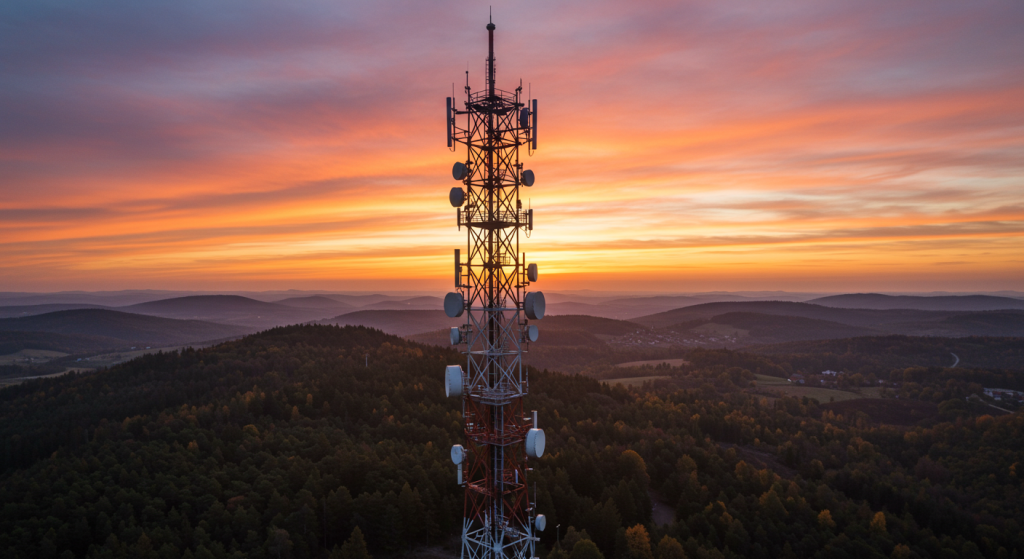Telecom Monopole Towers: Design, Installation, and Pros
2025-05-22
What is a Telecom Monopole Tower?
A telecom monopole tower is a free-standing mast structure (telecommunication monopole) that is self-supporting and constructed as a single unit, a galvanized steel monopole. The main feature defining a telecommunications monopole is that they are smooth and slender in profile as opposed to lattice towers or guyed towers, making it more appealing in urban areas and rural settings.
- Their primary function is to act as a mount for equipment that entails mobile networks, cellular monopoles, radio mast monopoles, and other wireless communications.
- Monopole towers exist in other shapes and forms, such as tapered multiple towers, polygonal monopole towers, and conical monopole towers. They also possess advanced bolt flange connection monopole or overlap connection monopole designs to make them more rigid and ostensibly simpler to construct.
Telecom Monopole Tower Construction Specifications
When constructing a telecom monopole, a vertical tower with self-supporting steel arms, a range of issues should be taken into account first about the structure's safety, functionality, and even durability. Meteorological Conditions: The structure needs to consider wind speed and the thickness of ice accretion. These are harsh weather particulars. The amount of wind that is present adds to dynamic loads that are placed on the tower alongside the antennas, meaning that it needs to withstand peak gusts, which can be common in the particular region. On top of that, ice formation also increases the deadweight and diminishes the area, enhancing the strain and a bit on the wind, which again places demands on a stronger structure.
- Tower Height:
The Coverage area, along with the signal quality requirements, dictates the height of the tower. Greater heights allow more antennas to be mounted and greater distances to be covered, but increase risks due to wind load or structural sway.
- Antenna Quantity:
The quantity of antennas placed does impact the wind and load resistance to be placed on the tower. The greater the number of antennas placed, the greater the demand on the design due to increased weight and wind pressure.
- Foundation Construction Conditions:
The design of the foundation is impacted by the soil type, bearing capacity, and level of groundwater. Deep or pile foundations are required in soft soils, while simple foundation structures can be used in stable soils.
- Tower Form:
The design of the towers is generally three or four-legged. Three-legged towers use less material and are cheaper, while four-legged towers are more stable and better for load distribution.
- Tower Construction:
Common construction types include angle steel frameworks, steel tube structures, or monopoles. Angle steel helps in quick assembly and maintenance, which is not the case for steel tubes due to having aerodynamic advantages. Monopoles help in saving space but require precision engineering.
Why Opt for Telecom Monopole Towers?
1. Multifunctional & Artistically Appealing
Monopole towers require less space, so they are ideal for densely populated urban areas. Their design is neat and sophisticated, which aids in reducing the visual impact, enhancing blending into the city landscapes. Camouflaged monopole towers that masquerade as trees or flagpoles also take care of maintaining the aesthetic beauty of the neighborhood.
2. Strong Construction
Steel monopole towers with high-grade galvanization can endure pounding by strong weather. Monopole towers possess an aerodynamic monopole shape for reducing wind-induced oscillations, making them virtually sway-free. Also, with a single pole configuration, there are fewer joints and therefore minimal maintenance is required over their entire lifespan.
3. Economic During Deployment
In comparison to lattice or guyed towers, monopoles have fewer components along less foundation work. This results in a decrease in time and expenses for the installation of monopole towers. The compact design also lowers site preparation costs and speeds up the rate of deployment, which is important for telecom projects.
4. Various Applications
Monopole towers cater to a wide array of wireless infrastructure needs. These include CCTV mast monopoles along with radio and TV broadcast monopoles. Their versatility is unparalleled. Whether it is a 30m or 50m monopole, these structures can be tailored to your project's specifications.

Proprietary Design Considerations of Telecom Monopole Towers
The design process of telecom monopole tower takes into consideration maximal structural optimization in terms of strength and minimal material input. The factors of designing a monopole tower include:
• Loading capacity:
The total weight of the antennas, microwave dishes, and cables, along with the environmental loads such as wind, ice, and snow, needs to be accounted for. Safe and stable operation will only be ensured with proper calculations.
• Foundation needs:
Monopole towers require a small yet strong foundation, which is usually a reinforced concrete base that is subjected to bending moments and shear forces.
• Material choice:
For the best results regarding heaviness and corrosion resistance, quality galvanized steel is the preferred material.
• Height:
Erected to fulfill designated height requirements, towers are usually built to a height of 15m to 50m, depending on the area of coverage and required signal strength.
Installation Approach Directory
The professional teams first assemble modular components, set up the monopole tower foundation, and then use cranes or hydraulic lifts to erect the pole. Either flange connection monopoles or overlap connection monopoles are used to join the sections. They secure them using twistable joints. Subsequently, the tower is outfitted with antennas and other necessary accessories, installed with cables positioned for longevity.
Types of Telecom Monopole Towers and their Distinctions
Despite the popularity of telecom monopole tower in modern structures, it is useful to explore other alternatives:
• Lattice Towers: They have a bigger footprint, which increases their visual impact. Robust and sturdy, these towers are often used where heavy antennas and multiple equipment arrays are required.
• Guyed Towers: These towers are raised with wires and can reach the highest elevation, but require vast amounts of land area for the anchors.
• Stealth Towers: Versatile monopole towers that can be covertly built as trees or flagpoles, stealth towers are designed to blend with the environment.
• Rooftop Towers: Ideal for urban settings due to the absence of additional ground footprint, these towers are mounted on the rooftops of buildings.
Uses of Telecom Monopole Towers
• Mobile Monopoles: Bases for cellular antennas.
• Telecommunication Network Backbone: Foundation of urban and rural wireless networks.
• Broadcast Monopoles: Used for signaling and transmitting radio and television signals.
• Radio Mast Monopoles: Supporting communication networks and emergency services.
Choosing Your Telecom Monopole Tower
For each tower model, keep in mind:
• Height requirements: Based on coverage area and desired signal strength.
• Environmental considerations: Wind speeds, seismic activity, and weather.
• Design considerations: Preference for tapered, polygonal, or conical monopole design.
• Installation constraints: Accessibility and foundation of the site.
• Mast Aesthetic considerations: For protective concealment, consider stealth or disguised monopoles to help shield sensitive urban locations.
Why are You Best Placed to Serve as Your Telecom Monopole Tower Poe Handlers?
At XY Towers, we are experts in designing, manufacturing, and installing high-grade steel monopole towers customized to meet your project requirements. Our project experts ensure all towers are supplied within the confines of the prevailing regulations as regards safety, durability, and efficiency. We provide:
• Affordable rates with prompt supply.
• Custom pole designs, which include monopole towers and antenna monopole towers mounted on a mast.
• Comprehensive professional support post-installation.
• Responses about the telecom infrastructure of urban and rural areas.
Conclusion
One of the fundamental parts of the wireless network is the telecom monopole tower. It has a modern appearance and is highly durable, which makes it cost-effective, enhancing its adoption by providers across the globe. Whether you are looking for a cell tower monopole for an urban setting or a rural monopole tower for increased coverage areas, monopole towers offer flexible and dependable options. Check out the variety of monopole towers and installations offered at XY Tower.

Hey, I’m Chunjian Shu
"X.Y. Tower: Reliable, innovative solutions for high-quality towers and electrical equipment with professional service.
